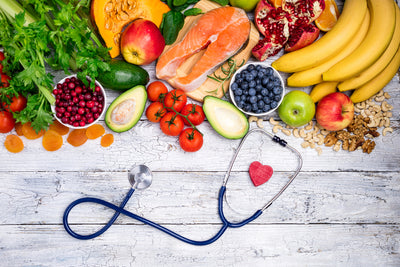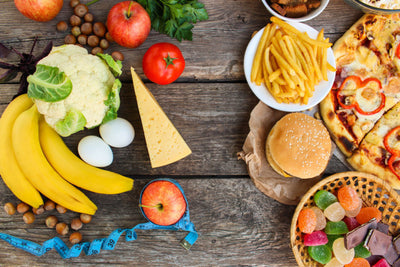
Heal Your Gut
How to restore a healthy gut
A healthy gut is the centre piece to overall wellbeing. With an optimally functioning gut we digestive food better, we absorb more nutrients, feel better and look better. The state of our immune system, our skin, hair and energy all have a strong relationship with the health of our gut which is why it is so import we look after it.
The gut has important relationship between the internal body and the environment we live in. Every meal involves an intense extraction process of breaking down food into its molecular components which are used inside the body. Our gut must then distinguish what nutrients are beneficial and reject the harmful ones, including chemicals, bacteria, viruses, fungi.
Immediate Signs of Gut Troubles
- Gut pains and aches
- Bloating
- Indigestion
- Diarrhoea
- Constipation
Long term gut troubles
- Mental fog
- Migraines
- Allergies
- Asthma
- Acne
- Rashes
- Eczema
- Fatigue
Step 1: Eliminate Inflammatory Foods
- Cut out sugar
- Cut out refined carbohydrates
- Avoid common allergenic foods such as wheat and dairy
Step 2: Nutrient dense gut building foods
- Eat a bounty of various vegetables
- Smooth out with soluble fibre and fluid
Step 3: Supplement
- Collagen and Bone broth
- Hydrochloric acid
- High quality gut formula with Digestive Enzymes
Immediate Signs of Gut Troubles
Gut pains, aches, bloating, indigestion, diarrhea, and constipation are not uncommon problems. In fact, if digestive troubles are happening frequently, these should be viewed as helpful signs that your gut needs care and attention. Less obvious signs of poor gut health also show up several other places across the bod in the form of mental fog (noticeable after meals), migraine headaches, seasonal allergies, asthma, skin issues such as acne, rosacea, hives, rashes, or eczema, low mood, anxiety, chronic fatigue, and recurrent yeast infections.
If these concerns are common for you, here are the top three step to get started on building up a healthy gut.
Step 1: Eliminate Inflammatory Foods
Gut trouble is often one of the first reactions to eating inflammatory food. Redness, pain, and swelling are key pointers to inflammation which can occur at a single point or throughout the body. Eating less inflammatory food is one of the most immediate things one can do to combat whole-body inflammation and support healthy gut function.
Cut out Sugar
Sugar, including glucose, fructose, cane sugar, and any kind of syrup has zero nutritional value which is why it is sometimes referred to as empty calories. There are only benefits to cutting out sugar.
One reason is refined sugar acts as rocket fuel for potentially harmful bacteria and yeasts such as candida that live in the gut and mouth. Cutting off the available fuel for these microbes reduces the overall toxic load on the immune system and supports beneficial bacteria to thrive.
Sugar is not only in the sweet stuff like sweet drinks, cakes, biscuits, and chocolate. Sugar is also a common ingredient in many processed and packaged food including stir-fry and pasta sauces, meat marinade, seasoned deli products, crackers, bread, soups, dairy products, and breakfast cereals.
The simplest way to cut out sugar is by choosing minimally processed whole foods which your grandmother would recognise. When choosing packaged food choose those with short ingredients lists and minimal additives.
Cut out refined carbohydrates
The second biggest culprit in the inflammatory western diet is all the other refined flour, grains, and processed seed oils (canola, grapeseed, soybean, rice bran, cotton seed). These are in all kinds of flour in bread, baking, snacks, crackers, pastry, and generally most packaged food.
Because refined flour has been processed and broken down from its whole natural form, it is very quickly digested and transformed into sugar. Choosing foods made from processed flour can create problems similar to eating sugar.
Refined carbohydrates create free radicals when they are burned to make energy in the body. Having large amounts of free radicals in the body from eating a diet high in processed food contributes to inflammation.
Choose whole unprocessed food including vegetables, beans, peas, and grains are the best dietary sources of carbohydrates. These whole foods not only provide energy, they’re tied with essential vitamins, minerals, fiber, and phytonutrients that are needed to fuel a strong healthy metabolism.
Avoid Allergenic foods
Some people tolerate certain foods better than others and some people are even allergic to certain common or even healthy foods. Common allergenic foods include wheat, dairy, egg, corn, other grains, soy, yeast, nuts, and seeds.
If you are aware of foods your body is not tolerating or reacting to, cut them out totally for a period of at least 4 weeks and monitor for any change in symptoms before reintroducing.
Step 2: Nutrient dense gut building foods
The gut loves being fed plenty of nutrients to function well. Essential vitamins, minerals, essential fatty acids, amino acids, and phytonutrients provide the building blocks for intestinal cell strength and function as well as, fuelling the healthy gut bacteria.
Eat a bounty of various vegetables
Vegetables should be the bulk foundation of your diet. In seek of varying nutrient combinations found in all vegetables, choose a variety for colours and flavours daily. A wide array of vitamins and minerals can be sourced from all families and colours of vegetables.
Nutrients are needed to build healthy cells and support various functions such as producing digestive enzymes, building a tight intestinal barrier, and having an efficient immune response to invaders.
Rich coloured plant foods (reds, purples, blues, blacks) contain polyphenols and anthocyanins which are known to feed healthy gut bacteria and offer powerful anti-inflammatory properties.
Over a week, aim to eat vegetables from each family of plants listed below.
- Dark green leafy vegetables: Spinach, watercress, silver beet
- Cruciferous: Broccoli, cauliflower, kale, cabbage, bok choi
- Ilium: Onion, leek, chives, garlic
- Parsley: Celery, fennel, celeriac, parsley, rocket
- Reds, orange, yellow: Carrots, sweet potato, capsicum, tomato, chili
- Purples, blues, blacks: Red cabbage, beetroot, purple carrots and potatoes, currants and berries, heirloom tomatoes, black garlic, black sesame, coffee, cacao
- Herbs and spices: coriander, fennel, turmeric, black pepper
Smooth out with soluble fibre and fluid
A healthy gut needs to be kept moving to flush out toxic material and supply fresh nutrients to the intestinal lining. Be sure to include soluble fibre and adequate fluid to maintain daily soft bowel motions.
Soluble fibre is the soft gummy fibre found in fruit and vegetables as well as some seeds and whole grains. To name a few, it is found in inner flesh of sweet potato, pumpkin, cucumber, avocado, apple, banana, and pear. Slippery elm from the herb shop and inner leaf gel of aloe vera also contain similar soothing properties.
Soluble fibre absorbs moisture, and like a soggy sponge, brushes through the intestinal tract to assist bulk movement and transit of waste material.
Some forms of soluble fibre are also classed as prebiotic fibre. Prebiotic fibre such as inulin provide food to beneficial bacteria and selectively promote their growth. Jerusalem artichoke is one of the best known dietary sources of inulin prebiotic fibre.
Remember, when increasing fibre and vegetable intake be sure to drink plenty of fluid to encourage soft regular bowel motions. Pure filtered water and herbal teas are best.
Step 3: Supplement
Supplements hold their place as a very useful addition or supplementary to an integrative treatment plan from which good nutrition and lifestyle are the foundations.
Collagen and Bone broth
While bone broth does not necessarily hold up as a true good quality source of essential minerals for the gut, is contains high levels of conditionally essential amino acids which are key to healthy connective tissue production. Glycine, glutamine, and proline are “conditionally essential” amino acids which are scarcely found in the refined western diet as well as low-fat and vegetarian diets. In the state of digestive stress, the gut can benefit from more of these amino acids.
Proline is needed for collagen, cartilage, connective tissue, and proteoglycan production. Glycine is used to make more amino acids and is needed even more so in times of stress, infection, illness, detoxification, sports, and pregnancy. Glutamine provides energy to intestinal cells, is important for gut healing, the growth of villi, the immune system, cell growth, and muscle building.
Hydrochloric acid
That’s right acid. Having enough stomach acid is key for starting the major digestive processes. If you have sub-optimal stomach acid production, often characterised by reflux, heartburn, or prolonged feeling of stomach heaviness after meals, I would recommend a hydrochloric acid supplement (Betane HCL) before meals. In particular, meals with high protein containing animal products require more stomach acid than vegetable based meals. Supporting good digestion early on from the stomach will aid efficient digestion further down the digestive tract.
High quality gut formula with Digestive Enzymes
An intelligently formulated gut formula is helpful to ensure there is an ongoing supply of essential nutrients such as zinc and glutamine to support the gut lining in times of increased need. In addition, some formulas contain natural ingredients that are difficult to source naturally from diet alone.
Digestive enzymes are small active proteins that break down food into smaller molecules and individual nutrients for absorption. Naturally, digestive enzymes are produced by glands along the digestive tract but decline as we age. Good digestion not only helps to provide nutrients but can also support the balance of gut bacteria. Adding an enzyme supplement is helpful when the gut lining is inflamed and natural digestive enzyme production or function is compromised. Ultimately, enzymes support the release of nutrients to can be utilised by the body which means getting the best nutritional value out of your diet.
I like the Biosphere Digestive aid because it combines a handful of key gut supporting ingredients into one sachet. They have managed to sweeten and flavour their powder without artificial chemicals, fillers, and sweeteners which many other companies use.
It’s great to see the use of scientifically researched and patented ingredients which leads me to feel confident in receiving true functional benefit with each dose. At home, using Biosphere’s formula with 95% Curcumin and Bioperine black pepper extract would be far more potent and pure than if I were simply to use turmeric and pepper from my spice rack – and no doubt, the mango flavoured powder would taste much better in a smoothie.
A scientifically backed prebiotic fibre made from non-GMO corn is also really encouraging to see. We know not all bacteria are created equal. Especially for anyone with signs of bacterial overgrowth or dysbiosis, it’s important to choose a fibre product which will encourage the growth of good bacteria as opposed to feeding the nasty ones.
Biosphere’s gut formula has a good dose of zinc and glutamine which are key for supporting the gut cell lining and proliferation as well as immune cell function. Zinc in the bisglycinate form which is thought to be well absorbed. I was particularly impressed with the use of patented Sutamine which provides the functional benefit of both L-Alanine and L-Glutamine for supporting healthy gut and immune cell function.
The digestive enzyme blend is excellent. This comprehensive patented blend includes amylases (carbohydrate-digesting), proteases (protein-digesting), and lipases (fat-digesting) – deserving three big ticks. Undigested food can be a problem for many when left further down the digestive tract. Key advice I tend to offer it to chew your food well, eat slowly, and look at using a digestive aid like biosphere’s formula with heavy meals.
Take home message
In summary, it’s important to recognise the hierarchy of addressing gut issues. Simply eating more or less of one thing or adding in a supplement is not a “fixes all” solution. There is a slow process which starts with wiping out foods that aren’t so helpful (and potentially harmful) and working with including more foods to provide nutrients and fuel good bacteria. It’s all about slowing down, tuning in, and listening to your gut (excuse the pun). A good gut formula can then work to support on top of this process. For more info on the unique Biosphere gut formula see here.






